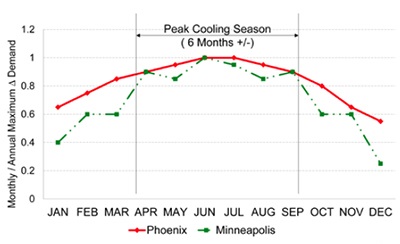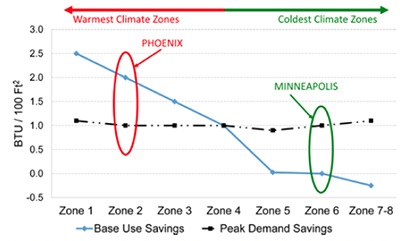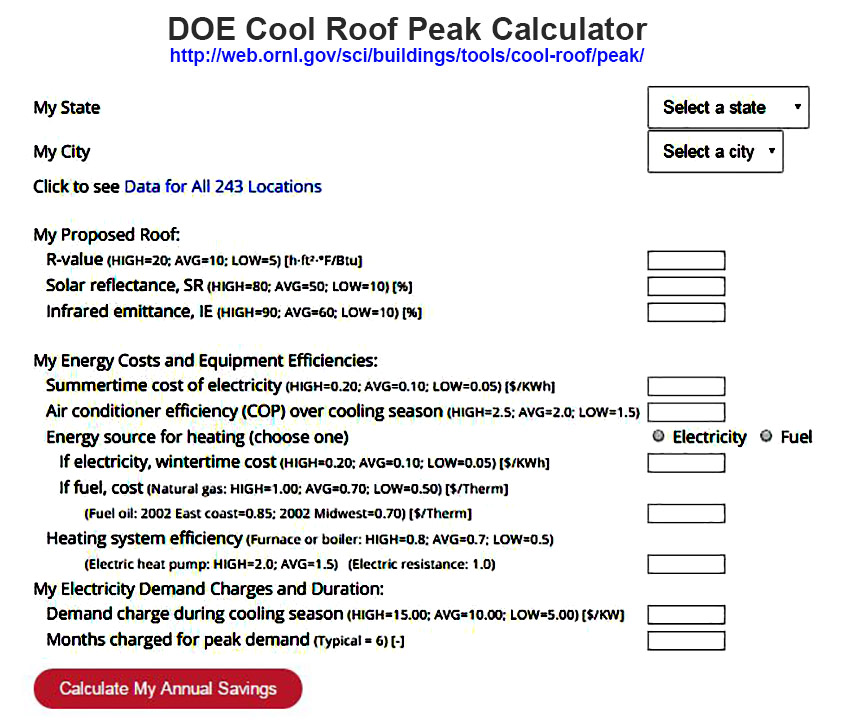Reducing Peak Electrical Demand
Peak Demand: Not Just a Warm Climate Problem
In order to better understand the benefits of cool roofs in reducing peak energy demand, researchers at Oak Ridge National Laboratories6 examined the seasonal variation in peak air conditioning demand for a variety of different climates across North America. Their findings suggest that even though base cooling demand may be higher in hot climates as compared to cooler climates, almost all climates exhibit a seasonal variation in the peaks for roof related air conditioning demand. Figure 4 compares this seasonal trend for a hot, cooling-oriented climate (Phoenix, Ariz.) and a cold, heating-oriented climate (Minneapolis, Minn.). Although Phoenix exhibits a higher and more consistent monthly demand for air conditioning as compared to Minneapolis, demand falls off at the beginning and end of the year for both cities, with a substantial portion of peak demand located within a six-month period from April to September. As a result, it may be possible to reduce peak demand in both cities using cool roofing technologies. In fact, a recent study of cool roofs and peak demand costs suggests that the potential for roof-related peak demand savings for hotter cities like Phoenix and colder cities like Minneapolis may be approximately identical7. Figure 5 illustrates the comparative base energy and peak demand savings for the seven major climate zones in the U.S. identified in this study.
 |
 |
Although the colder climate zone for Minneapolis offers little or no savings potential in terms of base use, the opportunity for peak demand savings is approximately the same as in much hotter climate zones. Although it may seem counter-intuitive that similar peak energy savings may be achieved in cold climates as well as hot climates, Figures 4 and 5 taken together may help explain this apparent paradox. In a hot location such as Phoenix, even though overall cooling loads are very high, the seasonal peak is less pronounced, while the seasonal peak in a cold location such as Minneapolis is much more pronounced even though the overall cooling loads are smaller. In effect, peak demand savings in hot climates may be described as a smaller piece of a larger pie, while peak demand savings in cold climates may be described as a larger piece of a smaller pie.
Beyond the Dollars: Other Costs of Peak Energy Demand
So far we have discussed the immediate economics of peak demand, but there are other costs associated with peak demand that should be discussed as well. Because additional electrical generating capacity is required to meet peak demand levels, it is likely that this will lead to increased atmospheric pollution and environmental impacts due to the need to construct new generating facilities as well as the less-than-efficient operation of existing facilities. Peak energy demand also is strongly associated with the overall heating of large cities and urban areas, commonly referred to as the Urban Heat Island Effect. In turn, increased warming of urban areas may lead to increased production and accumulation of ground level ozone, which in turn may lead to increased health risks and a growing number of “Ozone Action Days” in cities and towns across North America. Finally, increasing peak electricity demand may increase the potential for “brownouts,” especially during unusually hot weather events.
How to Estimate Peak Demand Savings
The good news for building owners and designers is that the U.S. Department of Energy has developed an online calculator specifically designed to evaluate peak demand and cool roofs: The Cool Roof Peak Calculator9. This online calculator, developed by Oak Ridge National Laboratory, provides a fast and easy way to compare the overall energy costs and savings for a wide variety of roof and building conditions. The calculator is easy to access and comes with step-bystep instructions for the user. Because the DOE Cool Roof Peak Calculator includes climate data for over 200 cities across North America, it’s easy to find a model location that can match up with almost any site in the United States or Canada. Unlike some energy calculators that model steep slope residential roofs with attics, the Cool Roof Peak Calculator models the typical low slope commercial roof with insulation placed directly over the deck and under the roofing membrane.
Using the DOE Cool Roof Peak Calculator is simple and straightforward, but some specific information is required to operate the calculator effectively. To obtain the maximum benefit from the calculator, the user must identify the following building attributes and conditions:
Figure 6 provides and illustration of a partial screen shot of the Cool Roof Peak Calculator from the web site of Oak Ridge National Laboratory.

- Location. The user first must select a U.S. state or Canadian province and then select the closest city from a list provided for each state and province. As an example, the state of Ohio includes data for Akron, Cleveland, Dayton, Mansfield, Toledo, and Youngstown. For all states, an ample number of model cities is provided to allow the user in other cities to make an accurate climate-based comparison.
- Proposed Roof R-Value. If the calculator is being used by a building or roofing professional familiar with past and current energy codes, it is likely that the roof R-value may be estimated based on the age of the roof or building. For the non-professional, the calculator instructions provide suggestions for “high,” “average,” and “low” insulation R-value levels across North America.
- Proposed Roof Reflectance. Roof reflectance is stated as a ratio similar to the values shown in Table A. Roof reflectance for a specific roofing product may be obtained from roofing manufacturer data sheets or from the EPA Energy Star or Cool Roof Rating Council Web sites mentioned previously. Once again, the calculator provides suggestions for “high,” “average,” and “low” roof reflectance values. It should be noted that the aged reflectance value should be used in order to accurately estimate the long-term ability of the roof to reflect solar energy.
- Proposed Roof Infrared Emittance. Roof emittance is also stated as a ratio similar to roof ref lectance. A full discussion of emittance is beyond the scope of this paper, but essentially it is a measure of the amount of solar energy absorbed into the roof but eventually transmitted back to the atmosphere rather than into the building. Roof emittance for a specific roofing product may be obtained from roofing manufacturer data sheets or from the EPA Energy Star or Cool Roof Rating Council web sites mentioned previously. Once again, the calculator instructions provide suggestions for “high,” “average,” and “low” roof reflectance values. However, the values shown on the calculator may provide a much wider range than typically found in most low-slope roofing membranes. Typically, the thermal emittance of common single-ply and asphaltic roof coverings runs within a range of 0.75 to 0.90.
- Base Energy Costs. The calculator assumes that the building is being heated in the winter and cooled in the summer, but the user must identify the types of fuel used to heat and cool the building as required. Because the calculator assumes electricity will be used to cool the building, the user must enter the “summertime” cost of electricity in $/kWh, which is identical to the base use rate discussed previously. (Note that the peak demand charge for electricity is entered later in the calculation.) Next, the user must indicate the type of fuel (electricity, natural gas, or fuel oil) used to heat the building as well as the wintertime cost of the fuel. In the case of electricity, the cost is measured in $/ kWh and is the same as the base use rate as determined from an electric bill. For natural gas and fuel oil, the cost is measured in therms. Again, the calculator instructions provide a suggested range of typical fuel prices across North America.
- Equipment Efficiencies. After identifying the types of fuel and their corresponding unit costs, the user must enter the efficiency for the air conditioning and heating equipment used in the building. Suggested efficiencies are provided in the calculator instructions.
- Electricity Demand Charges and Duration. Finally, the user must enter the peak demand charge for the building, measured in $/kW. As discussed previously, this demand charge should be determined from a recent electric bill as illustrated in Figure 2. In addition, the user must enter the duration of the peak air conditioning season for the building, which typically is a six month peak cooling season, as illustrated in Figure 4.
Based on the information provided by the user, the Cool Roof Peak Calculator then will provide an estimate of the total roof-related energy and demand savings for the building and roof system selected. In addition, this total cost amount is broken down into three key cost components:
- Cooling Energy Savings. This amount includes total air conditioning savings from both base use and peak demand reductions.
- Heating Energy Savings/Heating Penalty. This amount includes any changes in overall heating costs due to the cool reflective roof. Essentially, this estimate helps to account for any heating losses incurred in winter when solar radiation that could help heat the building is reflected back into the atmosphere.10
- Cooling Season Demand Savings. This is an estimate of the reduction in peak demand charges due to roof reflectivity. The amount shown is included in the cooling energy savings previously identified.
It is important to note that all costs provided by the calculator are stated in dollars per square foot of roof area. As a result, these costs must be multiplied by the total square footage of roof surface area to estimate annual cost savings for the entire building.
It is also important to note that the DOE Cool Roof Peak Calculator is designed to compare the total roof-related net energy costs for a cool roof with a reflectivity as specified by the user to a black roof with a solar reflectance of 0.05 (5 percent). If the user wishes to compare two cool roofs with different reflective ratings, the user may run separate calculations on each roof and then manually compute the difference in savings between the two roofs.









